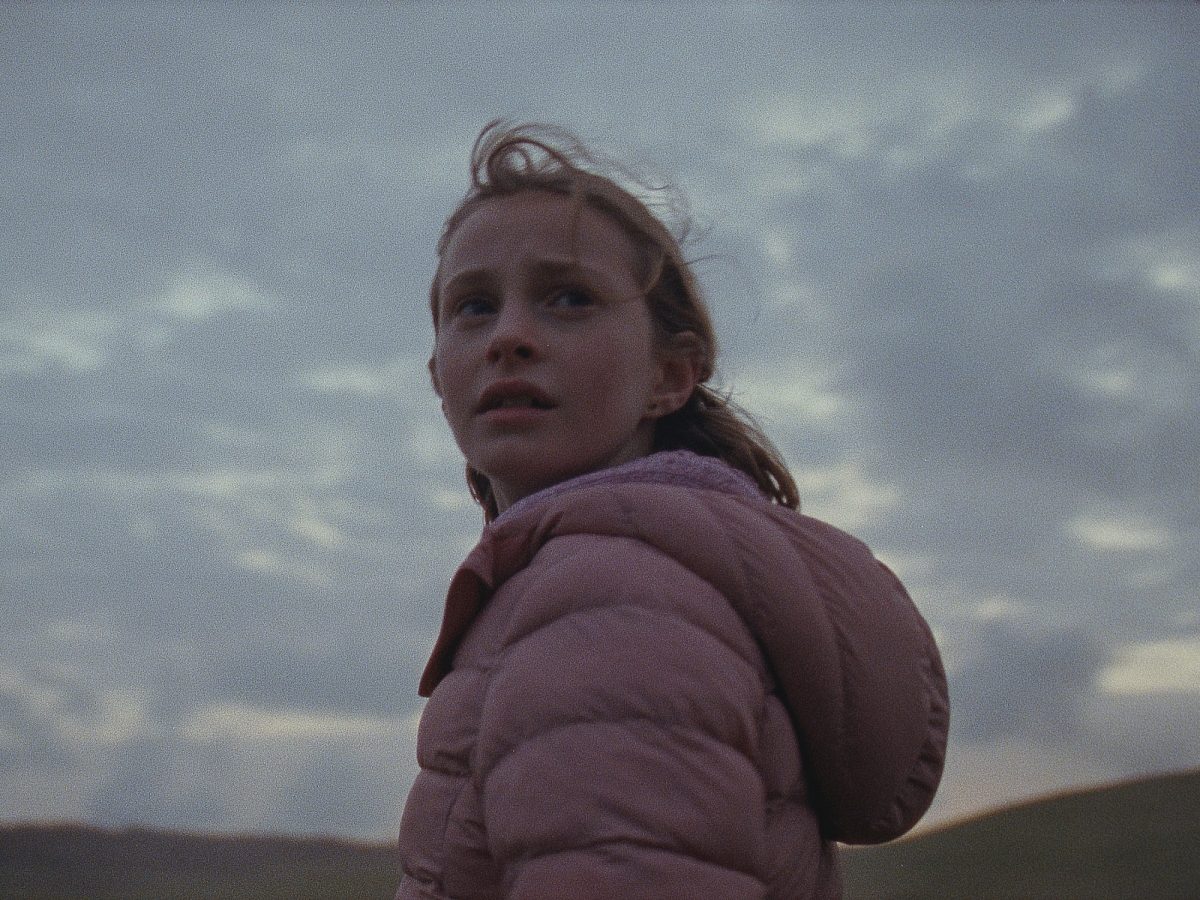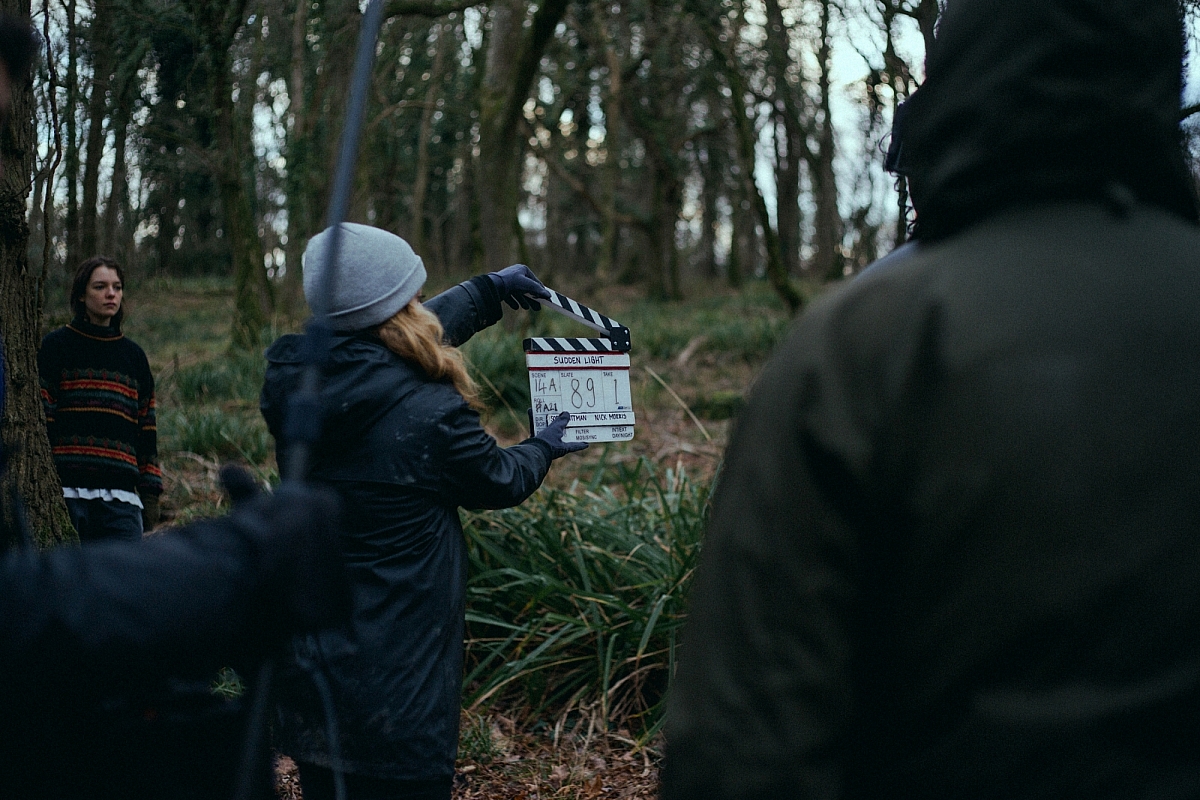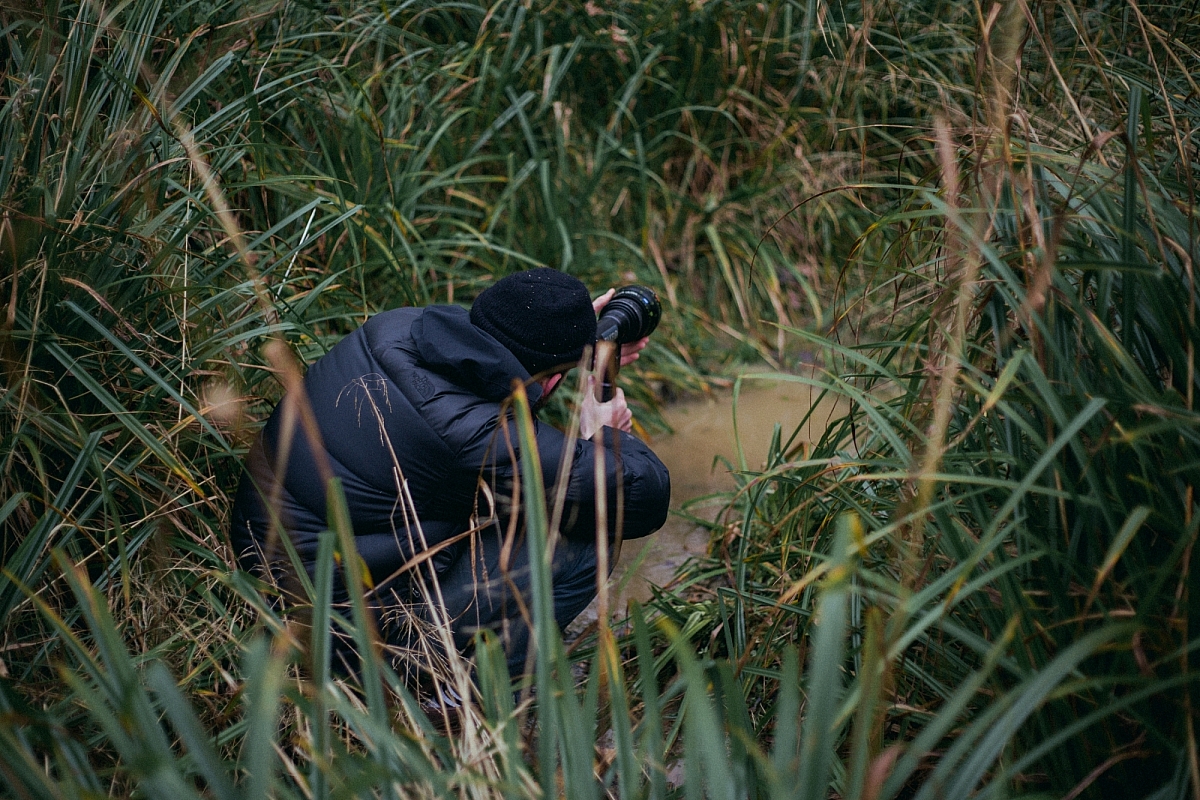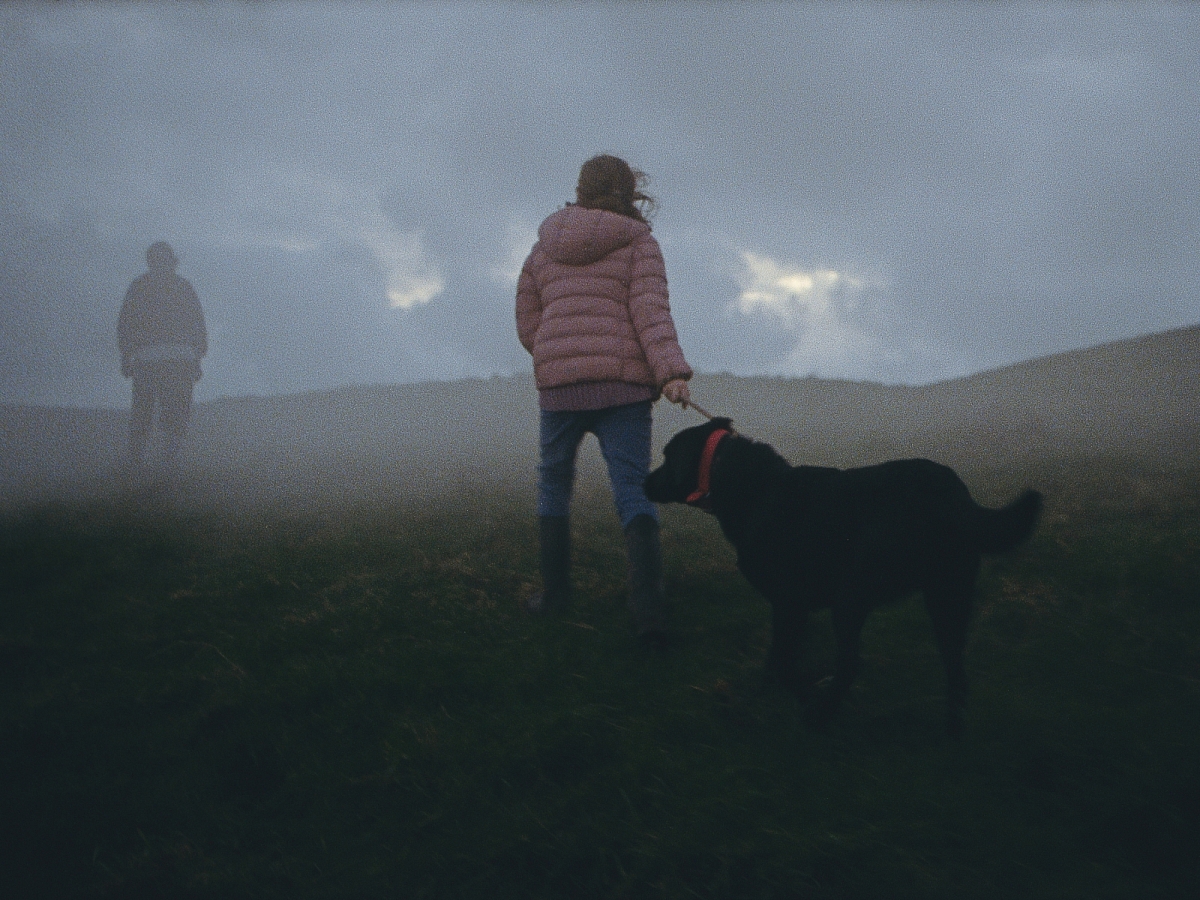Director Sophie Littman’s 2020 Cannes-contending short ‘Sudden Light’ harnesses Kodak 16mm to eerie effect

Millie Ashford as Squeeze in Sophie Littman’s short film "Sudden Light."
Prepare to be spooked. Shot on Kodak 16mm film, director Sophie Littman’s Cannes-contending short, Sudden Light, follows two sisters, Mia and Squeeze, who are dealing in different ways with their father’s rapidly deteriorating health in hospital. As they take their dog for a walk in the wintery fields nearby their rural home, they gradually become lost – familiar surroundings begin to warp and shift around them, spiralling them deeper into panic, forcing them to confront their emotions, while a strange man lurks at the edge of a dark wood.
Shot on a micro-budget of £20,000, by DP Nick Morris, and supported by BFI Network and Wellington Films, Sudden Light is officially selected for the 2020 Cannes Film Festival, in the Short Film Competition, where it will have its world premiere. The film stars Esme Creed-Miles as Mia, Millie Ashford as Squeeze, and Sam Spruell as a sinister stranger.
“I always wanted to shoot Sudden Light on film,” says Littman, a self-confessed devotee of analog production, whose previous credits include the short 16mm short Jellyfish (2016), which she shot in-camera using her own vintage, much-used and weather-beaten Canon Scoopic 16mm camera.

Esme Creed-Miles as Mia in Sophie Littman’s 16mm short "Sudden Light."
“As so much of the storytelling blurs the line between Mia’s heightened mental state and reality, I felt that only film would give me that dreamlike quality and lend itself especially to the light and landscapes of our wintery locations. Of course, making any film would be tough on the budget we had, but we made it work, and I am glad we fought for film.”
“When Sophie came to me with the script it was clear she wanted to achieve something that started in naturalism and realism, but then really dug into the strong, subjective experiences of the characters in quite an abstract way,” says Morris, who had previously shot music videos with Littman.

Sam Spruell plays the sinister stranger in Sophie Littman’s short film "Sudden Light."
“Sophie wanted to create a cinematic world within which the feelings of dread, panic, fear and anger surrounding their father’s illness could infiltrate the ways that the characters experience the world, and thus how the audience sees it too. To some degree, this meant that all of the usual constraints of geography, chronology, and simple things like the 180º rule were up for grabs, which was a really exciting prospect.”
Production on Sudden Light took place over the course of four short, freezing-cold days during the winter solstice of December 2018, at agricultural locations near Abbotsbury, just inland from Dorset’s Jurassic coast.
References considered by Littman and Morris included several films displaying how the natural world and the emotional state of the characters are linked, such as the avant-garde Post Tenebras Lux (2012, DP Alexis Zabe), The Master (2012, DP Mihai Malaimare Jr.) for its naturalistic use of shakey dolly moves, and Wuthering Heights (2011, DP Robbie Ryan ISC BSC) for the ethereal look and feel of faces within the landscape. Morris also contemplated the exposure arc in Loveless (2017, DP Mikhail Krichman) in which the action moves from day to night and back again over the course of the story.

The film crew at work on Sophie Littman’s 16mm short "Sudden Light." BTS photograph by Sofia Boriosi.
“I knew we had a lot of flexibility in how we could use the image to tell the story,” says Morris. “Shooting mainly in available light, the palette would be dominated by the compliment of the greens of the rolling hills and the natural skin tones of the talent, and only film would render both in an effortlessly beautiful way, without hours and hours of fiddly keys and windows later in the grade. Moreover, leaning heavily on natural light, I knew the 16mm film negative would deal really well with the range of weather and aggressive contrast in the woods, as well as the bare unfiltered sun.”
Along with the brief window of daylight hours every day, the production team had to contend with freezing temperatures, long off-road unit moves, as well as young actresses and animals, although Morris says the silver lining was consistently beautiful, low-angle sunlight all day long, and dramatic skies.
To keep up with the schedule Morris and Littman knew they would need a camera package that would be lightweight and fast to use. They originally intended to capture 4:3 aspect ratio in 4-perf 35mm, using the squareness of the frame to convey the constraints and mental unease of the characters.

Camera trainee Carrie Hajny at the clapperboard on Sophie Littman’s 16mm short "Sudden Light." BTS photograph by Sofia Boriosi.
However, during location scouts it became clear that the budget would not stretch to shooting on the larger negative format, plus the camera size and short run times of 4-perf would consume too much time while trudging through muddy fields and reloading in the freezing elements.
So, keeping the native 4:3 framing convention, the pair opted to shoot using an ARRI 416 16mm camera with a combination of fast, sharp Zeiss Ultra 16 and Master prime lenses, plus a Canon 11-165mm zoom, capturing on KODAK VISION3 50D 7203 and KODAK VISION3 250D 7207 Color Negative Films. Take 2 provided the camera/lens package, and the negative was processed/2K-scanned by Kodak Film Lab UK, based on the lot at Pinewood Studios.
“We shot nearly all of Sudden Light using the 50D, which I rated at between 12 and 25ASA,” says Morris. “By shooting wide-open with fast lenses and keeping the stock as clean and as fine-grained as possible, we brought the 16mm film as close as we could get it to our original 4-perf dreams, whilst also keeping up with the crazy schedule.
“Super 16mm shot at T1.3 gave us a similar depth-of-field to 4-perf shot at around T2.8 ½, so the main difference after that came down to things like grain density, resolution and halation. The very fine grain of 50D and the high-resolution lenses, alongside the thicker negative from over-exposing by two stops, certainly brought out a look that was very close to what we wanted to achieve.”

"Sudden Light" cinematographer Nick Morris eyes a shot in swampy marshland. BTS photograph by Sofia Boriosi.
For the scenes in a marshland swamp within the forest, when the plot and the emotional mood take a darker turn, Morris switched to VISION3 250D 7207.
“Filming deep in the woods, often during the last hours of the day, we tried to introduce more texture into the negative by shooting the 250D pushed by a stop,” he explains. “This helped us match scenes shot at dusk and day-for-dusk by crushing some detail from the blacks whilst creating a more contrasty look.
“Generally, we exposed for a much thinner negative, pushing the 250D to 500 and rating it at 640ASA. This placed more of the image in the toe of the curve, effectively desaturating the picture and giving those scenes the sense of grittiness that we would never have had the confidence to emulate in a grade had we shot digitally.”

A scene from Sophie Littman’s 16mm short "Sudden Light."
Reflecting on having shot on celluloid, Morris adds, ”Shooting on film not only brought a timeless, effortless look to the rushes before we’d even stepped into the DI grade, but it also had a dramatic effect on everyone while we were shooting. With only 12 rolls of film, the performers felt trusted to hit their A-game with limited takes. The whole crew ran with military precision, perfecting every rehearsal and then nailing every take. It really helped create a focused set for everyone.”
Littman says it is “surreal and pretty crazy” that her film has been included in-competition at Cannes 2020. “I am hugely proud of how everyone pulled Sudden Light together. It was an incredible team effort, during a no-frills and really physically demanding schedule. During the madness though, hearing the ‘whirr’ of film in the camera shoots my adrenaline straight up. You know you have to make it count.”
She concludes, “I am a massive advocate for shooting on celluloid. Sometimes film feels out the question if you have a small budget and limited resources. But you can take advantage of natural lighting, and having limited takes can actually be a strength. You really will gain something quite special if you shoot on film. The quality is embedded in the medium.”